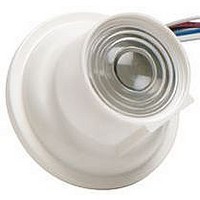DHIP HUBBELL WIRING DEVICES, DHIP Datasheet - Page 3

DHIP
Manufacturer Part Number
DHIP
Description
Daylight Harvesting Indoor Photocell
Manufacturer
HUBBELL WIRING DEVICES
Datasheet
1.HMHBSA.pdf
(28 pages)
Specifications of DHIP
Peak Reflow Compatible (260 C)
No
Leaded Process Compatible
No
For Use With
H-MOSS Motion Sensing Switches
Lead Free Status / RoHS Status
Contains lead / RoHS non-compliant
Hubbell Occupancy Sensors Play a Key Role
In the U.S., lighting consumes 22% of electricity and represents
$40 billion a year in energy costs. Using advanced technology,
Hubbell’s H-MOSS
to save energy and provide sustainability by automatically and
effectively turning lights on when a room is occupied and off
when a room is vacant. In a typical office building, where lighting
accounts for 35 to 45% of energy use, H-MOSS Occupancy
Sensors have the potential to reduce wasted lighting by 13 to 90%
for a significant return on investment (ROI).
Hubbell offers a broad range of occupancy and vacancy
sensors and lighting controls that meet the latest codes and
standards, including ASHRAE/IESNA 90.1 and CEC’s Title 24.
H-MOSS Occupancy Sensors can also provide LEED
categories like Sustainable Sites, Energy and Atmosphere, Indoor
Environmental Quality and Innovative Design Process.
Backed by Hubbell Service and Support
H-MOSS
initiative and superior service and support including:
For more information about Hubbell’s GreenWise™ initiative and access to our complete suite of on-line tools,
visit our website at www.hubbell-wiring.com/green.
Energy Conservation at the Forefront
A significant energy conservation movement has been established across the globe in the form
of local, state and national programs, standards and codes that call for energy efficiency in both
commercial and residential buildings. These codes and standards include:
As energy concerns increase, the “greening” of commercial and residential buildings will continue
through more stringent standards and additional energy conservation initiatives like the EPA’s ENERGY
STAR program and the 2030 Challenge that aims to reduce energy use by 50% by 2030.
• LEED
• California Energy Commission’s (CEC) Title 24 program enforces stringent standards and
• ASHRAE/IESNA 90.1 energy efficiency code requires interior lighting in buildings larger than 5000
• IECC
facilities through the U.S. Green Building Council (USGBC) promotes sustainable building design.
regulations to reduce energy consumption, including automatic lighting control and shut-off.
sq. ft. to be controlled with automatic devices.
lighting which is now adopted by most states in some form.
• Valuable online H-MOSS ROI worksheet for calculating energy savings
• Detailed H-MOSS online e-learning courses that can be taken anywhere, anytime
• Product selection guide for choosing the right H-MOSS Occupancy Sensor and technology
• Online specification assistance through spec wizard, AutoCAD drawings, templates and documentation
• Comprehensive design assistance for deploying occupancy sensors in a variety of applications
• Highly knowledgeable network of specification professionals and trained, dedicated sales staff
• Backed by Hubbell who is committed to safeguarding the environment through environmental stewardship,
innovative products and efficient operations
®
®
®
Occupancy Sensors are backed by Hubbell’s GreenWise™ sustainability
(International Energy Conservation Code) compliance requires automatic shut-off of
(Leadership in Energy and Environmental Design) certification in new and renovated
®
Occupancy Sensors are doing their part
®
points in
Conference Room
Storage Room
Private Office
Open Office
Classroom
Restroom
10% 20% 30% 40% 50% 60% 70% 80% 90%
Energy Savings
Percentage Range
www.hubbell-wiring.com
3













